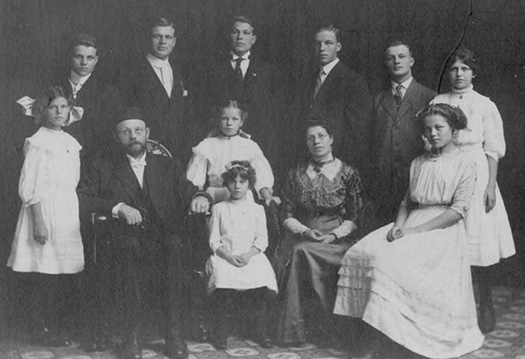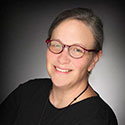Father’s Day and the Power of Story

It’s unlikely the name Sonora Smart Dodd rings any bells, but she is credited with the founding of Father’s Day. As a result of her work, the first Father’s Day was held on June 19, 1910, in Spokane, Washington.
On Father’s Day, we can celebrate all dads—biological dads, stepdads, granddads, uncles, brothers, adopted dads, mentors, coaches, or others.
One of my favorite ways to celebrate and honor those who have made an impact is through story. Storytelling is considered the oldest art form. Stories invite us to share experiences, express emotions, pass along traditions and wisdom, make sense of the world, and entertain.
The popularity of gatherings like The Moth, a nonprofit organization that “celebrates the commonality and diversity of human experience through the art and craft of true, personal storytelling” and the plethora of storytelling podcasts seems to demonstrate this point.
A recent The Moth Radio Hour podcast I found particularly beautiful is this episode, the theme being Remembering Our Loved Ones Through Story. In this episode, the host reflects that “Telling stories is a way to make sure precious memories about beloved family members get passed on to future generations and cement them in our collective memories.”
Sharing precious memories
Storytelling and its recent resurgence in popularity got me thinking about those precious memories my parents, grandparents, and other adults in and throughout my life shared about their experiences as kids, students, newlyweds, during times of national and world strife, growing older. Each story made an impact.
My Grandma Hulda’s family lived in the heart of our hometown, and they had a milking cow in their backyard. My Grandpa Ed sailed in iceboats on Lake Winnebago during Wisconsin winters. My Grandpa George shared that during WWI he wasn’t allowed to speak German outside of his childhood home in Cincinnati. My Grandma Evelyn played piano in a silent movie theater as a teenager. Later she became a teacher but had to quit when she married my Grandpa George during the Great Depression. My mom lived in a Quonset hut home in Arizona during WWII when my Grandpa George worked in a munitions factory. My dad told me about beaches and swimming pools being closed due to a polio epidemic when he was a kid.
Those are just a few of the memories shared through the years. There are so many questions I never got to ask. Looking back, I wish I’d had the forethought and tools to have asked more questions and gather and record their stories when they were still alive.
Father’s Day is June 19
Let’s embrace it as an opportunity to begin gathering those “precious memories about beloved family members.” Life stories are the best stories, in my humble opinion. Family stories are often enduring, more entertaining, offering deeper emotional connection, appreciation, and understanding.
Asking great questions
Consider starting with the Great Questions from StoryCorps (I’ve suggested this in past articles and everyone who has tried it loves it). StoryCorps has encouraged and collected thousands of stories and know what questions can get a good conversation going. Great Questions are organized into categories such as Great Questions for Anyone, Remembering a Loved One, Grandparents, Marriage & Relationships, Growing Up, Military, and Family Heritage, to name a few.
Here are “Stories to Reflect on for Father’s Day” to get you started.
Beautiful questions create powerful connections
Another approach I love is Beautiful Questions. Beautiful Questions was developed by Anne Basting to help create powerful connections with individuals living with Alzheimer’s and other dementias.
Beautiful Questions are open-ended and offer a multitude of pathways of discovery. This isn’t a way to learn a loved one’s stories, per se, but it offers a magical way to engage in conversation and create meaningful connection with a family member or friend who may be experiencing cognitive change.
Examples of Beautiful Questions would be, “What is something you treasure in your home and why?” and “What is the most beautiful sound in the world? Can you make it?”
As Basting shared in an interview on Wisconsin Public Radio, “It’s this thoughtful, poetic component of unlocking the world. You don’t want to have too many cognitive steps in the question but one that appeals to strength, and one that appeals to emotional memory, and that has a playful component as well.”
Documenting family legacy

Keri Pollock’s Grandma Hulda is the little girl who is standing in the middle of this 1917 family photo. To her right is Keri’s great-grandfather, a Danish Lutheran minister.
If gathering family stories as a project is of interest, you might enjoy the book Story by Story: 15 Projects to Write Your Family Legacy by Brenda Hudson. The projects in Story by Story are a great springboard to documenting lessons learned, family sayings, pivotal moments, mementos and family heirlooms. The projects are accessible for all ages.
I’ve been part of a small writer’s group for 15 years, and two women in the group are also genealogists. Part of the work they have been engaged in for years is gathering family stories. They’ve interviewed older members of their family to learn about others who are no longer living to understand their families’ immigration stories, family lore, and themselves.
Sharing History through Active Reminiscence and Photo-Imagery
In closing, I want to share a program that is in development here in Seattle—Sharing History through Active Reminiscence and Photo-Imagery (SHARP). SHARP Seattle is a “culturally celebratory walking and reminiscing program that aims to improve cognitive health among older African Americans.”
SHARP Seattle conducted focus groups to help shape the design of walking routes and themes for the program. Through the focus groups, input is being gathered to capture important historic landmarks, events, and people related to Black life in Seattle’s Central District.
Routes are being developed, with walking groups taking place in summer 2022. One-mile routes will be accessible on tablets, using GPS-triggered historical images of Black life in the neighborhood to prompt small-group reminiscence as participants walk. Together, these conversations will form a digital oral history archive.
Karen Winston, a planner in the Seattle Human Services Department’s Aging and Disability Services division, the City’s liaison for the Mayor’s Council on African American Elders, and a frequent contributor to AgeWise King County, has spearheaded many remarkable programs to bring culturally tailored dementia awareness and support for people of African descent. Winston partnered with Marigrace Becker of the UW Memory and Brain Wellness Center and with the Central Area Senior Center and other local organizations to pilot the SHARP model in Seattle. We look forward to hearing more soon!
Whatever your plans for Father’s Day—or any future family gathering—I encourage you to weave an element of story gathering and storytelling into the mix. Get your Great or Beautiful Questions ready now in anticipation. Plan a legacy project around a family saying. Keep an eye open for details about the SHARP Seattle program. Whatever you choose, have fun and build on the power of story!
 Contributor Keri Pollock directs marketing and communications for Aging Wisdom, a care management, consultation, and creative engagement practice based in Seattle. She is a member of the Age Friendly Coalition for Seattle and King County and serves on the Advisory Committee of the Frye Art Museum Creative Aging Programs and the Marcomm Council of the Alzheimer’s Association, Washington State Chapter.
Contributor Keri Pollock directs marketing and communications for Aging Wisdom, a care management, consultation, and creative engagement practice based in Seattle. She is a member of the Age Friendly Coalition for Seattle and King County and serves on the Advisory Committee of the Frye Art Museum Creative Aging Programs and the Marcomm Council of the Alzheimer’s Association, Washington State Chapter.
![AgeWise King County [logo]](https://www.agewisekingcounty.org/wp-content/themes/agewisekingcounty/images/logo.png)